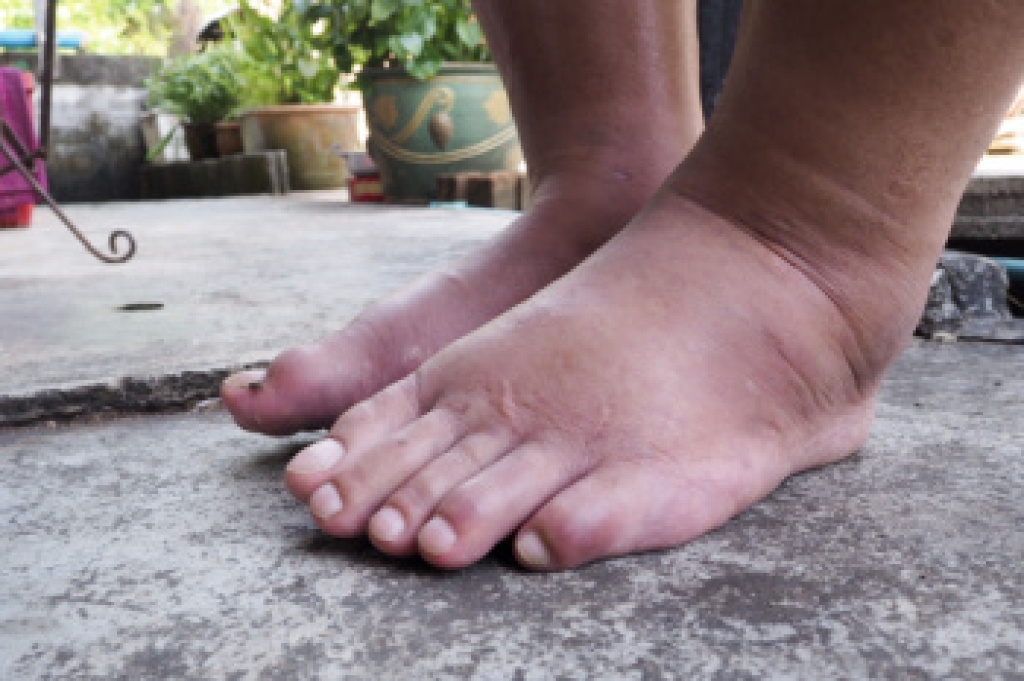Connect With Us
Blog
Blog
Causes of Swollen Ankles and Feet

Swollen ankles and feet can result from a variety of causes that should not be ignored. Cardiovascular concerns, such as poor circulation or heart disease, may lead to fluid buildup. Hormonal changes, particularly during pregnancy or menopause, can also contribute. Additionally, certain medications like those for blood pressure or diabetes may trigger swelling, while lymphatic issues can cause fluid to collect in the tissues. Infections in the feet or ankles can create localized swelling along with pain and redness. Risk factors include obesity, prolonged standing, age, and chronic medical conditions. A podiatrist can identify the underlying cause, provide treatment, and recommend preventive care. If you have swollen feet or ankles, it is suggested that you consult a podiatrist who can offer effective relief and treatment solutions.
Swollen feet can be a sign of an underlying condition. If you have any concerns, contact one of our podiatrists of Lexington Foot and Ankle Center, PSC. Our doctors can provide the care you need to keep you pain-free and on your feet.
Swollen feet are a common ailment among pregnant women and people who stand or sit for extended periods. Aging may increase the possibility of swollen feet and patients who are obese often notice when their feet are swelling too. There may be medical reasons why swollen feet occur:
- Phlebitis - A condition that causes the veins to become inflamed and can also cause leg pain.
- Liver disease - This may lead to low blood levels of albumin which is a protein. This can cause fluid in the blood to pass into the tissues and several areas of the body can become swollen.
- Heart failure - When the heart doesn’t pump properly the blood that is normally pumped back to the heart can pool in the veins of the legs causing swollen feet.
- Kidney disease - One of the main functions of the kidneys is releasing excess fluid in the body. This type of condition can make it difficult for the kidneys to function properly, and as a result the feet may become swollen.
- Deep-vein thrombosis (DVT)- This is a serious condition where blood clots form in the veins of the legs. They can block the return of blood from the legs to the heart which may cause the feet to swell. It is important to be treated by a podiatrist if this condition is present.
Swollen feet can also be caused by bone and tendon conditions, including fractures, arthritis, and tendinitis. Additionally, there may be skin and toenail conditions and an infection may cause the feet to swell. Patients who take medicine to treat high blood pressure may be prone to getting swollen feet.
Many patients elevate their feet to help relieve the swelling and this is generally a temporary remedy. When a podiatrist is consulted the reason behind the swelling can be uncovered and subsequently treated.
If you have any questions please contact our offices located in Harrodsburg, Frankfort, Georgetown, and Lexington, KY . We offer the newest diagnostic and treatment technologies for all your foot and ankle needs.
Possible Causes of a Broken Toe
 A broken toe can often be the result of an injury, or a stress fracture in the toe may happen gradually. Additionally, the toe can break while stepping off of a curb unexpectedly, or if a heavy object falls on it. Common symptoms that are associated with a broken toe can include swelling, pain and discomfort, and it may be difficult to walk. An effective treatment method can consist of buddy taping. This is accomplished by taping the affected toe to the toe next to it, and this generally provides the support that is needed as the healing process occurs. In severe fractures, the bone may be protruding from the skin, and this will require immediate medical attention. If you have injured your toe, and it is bruised and swollen, it is suggested that you speak with a podiatrist, who can perform a proper diagnosis and offer the correct treatment options.
A broken toe can often be the result of an injury, or a stress fracture in the toe may happen gradually. Additionally, the toe can break while stepping off of a curb unexpectedly, or if a heavy object falls on it. Common symptoms that are associated with a broken toe can include swelling, pain and discomfort, and it may be difficult to walk. An effective treatment method can consist of buddy taping. This is accomplished by taping the affected toe to the toe next to it, and this generally provides the support that is needed as the healing process occurs. In severe fractures, the bone may be protruding from the skin, and this will require immediate medical attention. If you have injured your toe, and it is bruised and swollen, it is suggested that you speak with a podiatrist, who can perform a proper diagnosis and offer the correct treatment options.
Broken toes may cause a lot of pain and should be treated as soon as possible. If you have any concerns about your feet, contact one of our podiatrists from Lexington Foot and Ankle Center, PSC. Our doctors will treat your foot and ankle needs.
What Is a Broken Toe?
A broken toe occurs when one or more of the toe bones of the foot are broken after an injury. Injuries such as stubbing your toe or dropping a heavy object on it may cause a toe fracture.
Symptoms of a Broken Toe
- Swelling
- Pain (with/without wearing shoes)
- Stiffness
- Nail Injury
Although the injured toe should be monitored daily, it is especially important to have a podiatrist look at your toe if you have severe symptoms. Some of these symptoms include worsening or new pain that is not relieved with medication, sores, redness, or open wounds near the toe.
If you have any questions please feel free to contact our offices located in Harrodsburg, Frankfort, Georgetown, and Lexington, KY . We offer the newest diagnostic tools and technology to treat your foot and ankle needs.
Foot Protection for Construction Workers

Construction workers place significant stress on their feet due to long hours, heavy lifting, and uneven surfaces. Proper footwear is essential to prevent injuries and maintain foot health. Safety shoes with steel or composite toes, slip-resistant soles, and adequate arch support protect against impacts, punctures, and slips. Wearing improper footwear can lead to plantar fasciitis, stress fractures, bunions, or chronic joint pain. A podiatrist can assess foot health, recommend supportive footwear, and provide treatment for work-related injuries or pain. If you have foot pain from wearing the wrong shoes while working, it is suggested that you consult a podiatrist who can treat various foot conditions and guide you on protective footwear to wear during your workday.
While working on the feet, it is important to take the proper care of them. For more information about working on your feet, contact one of our podiatrists from Lexington Foot and Ankle Center, PSC. Our doctors will treat your foot and ankle needs.
Working on Your Feet
Standing on your feet for long periods of time can cause stress and pain in your feet. Your whole body may experience change in terms of posture, back pain, bunions, callouses and or plantar warts. There are ways to avoid these conditions with proper foot care, smart choices and correct posture.
Positive Changes
Negative heeled shoe – Choosing this shoe type places the heel slightly lower than the ball of the foot. These are great for overall foot health. Find shoes that fit you correctly.
Go barefoot – Our feet were not designed to be enclosed for all hours of the day. Try to periodically expose your feet to air.
Eliminate Pain
Foot Exercises – Performing simple exercises, incorporating yoga and doing stretches are beneficial. This will allow increased blood flow to the area and muscles of the foot.
Achilles tendon – Stretching the foot out flat on the floor will relax the calf muscles and tendon. These exercises can be performed almost anywhere. Make sure you add these exercises to your daily regimen.
With a little bit of this information and knowing more about foot health, you will notice changes. Foot stretches and proper footwear will help with pain and prevent further issues.
If you have any questions please contact our offices located in Harrodsburg, Frankfort, Georgetown, and Lexington, KY . We offer the newest diagnostic and treatment technologies for all your foot and ankle needs.
What You Should Know About Morton's Neuroma

Morton's neuroma is a painful condition that affects the ball of the foot, most commonly between the third and fourth toes. It is caused by thickening of the tissue surrounding a nerve that leads to the toes, often due to repetitive stress, wearing tight footwear or high heels. Foot deformities like flat feet or bunions can also be factors. Symptoms may include sharp, burning pain, or the sensation of having a pebble inside the shoe. The pain often worsens with activity or pressure and may subside when the shoes are removed. A podiatrist can diagnose Morton's neuroma through a physical exam, symptom review, and imaging such as ultrasound or an MRI scan. Treatment options include footwear modifications, custom orthotics, anti-inflammatory medications, or, in severe cases, surgical removal of the affected nerve. Early diagnosis can prevent the condition from worsening. If you are experiencing persistent forefoot pain or numbness, it is suggested that you schedule an appointment with a podiatrist for an expert evaluation and relief.
Morton’s neuroma is a very uncomfortable condition to live with. If you think you have Morton’s neuroma, contact one of our podiatrists of Lexington Foot and Ankle Center, PSC. Our doctors will attend to all of your foot care needs and answer any of your related questions.
Morton’s Neuroma
Morton's neuroma is a painful foot condition that commonly affects the areas between the second and third or third and fourth toe, although other areas of the foot are also susceptible. Morton’s neuroma is caused by an inflamed nerve in the foot that is being squeezed and aggravated by surrounding bones.
What Increases the Chances of Having Morton’s Neuroma?
- Ill-fitting high heels or shoes that add pressure to the toe or foot
- Jogging, running or any sport that involves constant impact to the foot
- Flat feet, bunions, and any other foot deformities
Morton’s neuroma is a very treatable condition. Orthotics and shoe inserts can often be used to alleviate the pain on the forefront of the feet. In more severe cases, corticosteroids can also be prescribed. In order to figure out the best treatment for your neuroma, it’s recommended to seek the care of a podiatrist who can diagnose your condition and provide different treatment options.
If you have any questions, please feel free to contact our offices located in Harrodsburg, Frankfort, Georgetown, and Lexington, KY . We offer the newest diagnostic and treatment technologies for all your foot care needs.
Blog Archives
- 2025
- 2024
- 2023
- 2022
- 2021
- 2020
